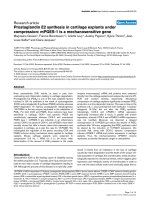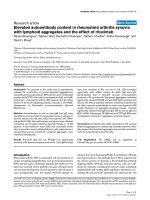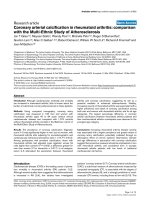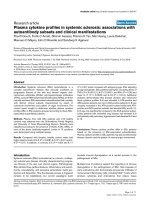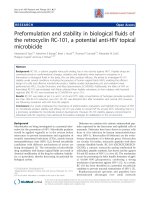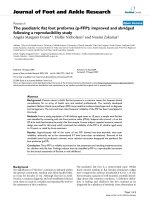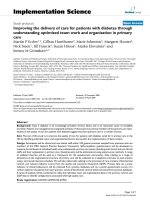Báo cáo y học: "Continuous venovenous hemofiltration in severely burned patients with acute kidney injury: a cohort study" potx
Bạn đang xem bản rút gọn của tài liệu. Xem và tải ngay bản đầy đủ của tài liệu tại đây (211.38 KB, 8 trang )
Open Access
Available online />Page 1 of 8
(page number not for citation purposes)
Vol 13 No 3
Research
Continuous venovenous hemofiltration in severely burned
patients with acute kidney injury: a cohort study
Kevin K Chung
1
, Jonathan B Lundy
1
, James R Matson
2
, Evan M Renz
1
, Christopher E White
1
,
Booker T King
1
, David J Barillo
1
, JohnAJones
1
, Leopoldo C Cancio
1
, Lorne H Blackbourne
1
and
Steven E Wolf
1,3
1
Burn Center, United States Army Institute of Surgical Research, 3400 Rawley E. Chambers Drive, Fort Sam Houston, TX 78234, USA
2
Pediatric Acute Care Associates of North Texas, PA, 7777 Forest Lane, D569, Dallas, TX 75230, USA
3
Department of Surgery, UT Health Science Center at San Antonio, 7703 Floyd Curl Drive, San Antonio, TX 78229, USA
Corresponding author: Kevin K Chung,
Received: 20 Feb 2009 Revisions requested: 12 Mar 2009 Revisions received: 8 Apr 2009 Accepted: 1 May 2009 Published: 1 May 2009
Critical Care 2009, 13:R62 (doi:10.1186/cc7801)
This article is online at: />© 2009 Chung et al.; licensee BioMed Central Ltd.
This is an open access article distributed under the terms of the Creative Commons Attribution License ( />),
which permits unrestricted use, distribution, and reproduction in any medium, provided the original work is properly cited.
Abstract
Introduction Acute kidney injury (AKI) is a common and
devastating complication in critically ill burn patients with
mortality reported to be between 80 and 100%. We aimed to
determine the effect on mortality of early application of
continuous venovenous hemofiltration (CVVH) in severely
burned patients with AKI admitted to our burn intensive care unit
(BICU).
Methods We performed a retrospective cohort study
comparing a population of patients managed with early and
aggressive CVVH compared with historical controls managed
conservatively before the availability of CVVH. Patients with total
body surface area (TBSA) burns of more than 40% and AKI
were treated with early CVVH and their outcomes compared
with a group of historical controls.
Results Overall, the 28-day mortality was significantly lower in
the CVVH arm (n = 29) compared with controls (n = 28) (38%
vs. 71%, P = 0.011) as was the in-hospital mortality (62% vs.
86%, P = 0.04). In a subgroup of patients in shock, a dramatic
reduction in the pressor requirement was seen after 24 and 48
hours of treatment. Compared with controls (n = 19),
significantly fewer patients in the CVVH group (n = 21) required
vasopressors at 24 hours (100% vs 43%, P < 0.0001) and at
48 hours (94% vs 24%, P < 0.0001). In those with acute lung
injury (ALI)/acute respiratory distress syndrome (ARDS), there
was a significant increase from baseline in the partial pressure
of arterial oxygen (PaO
2
) to fraction of inspired oxygen (FiO
2
)
ratio at 24 hours in the CVVH group (n = 16, 174 ± 78 to 327
± 122, P = 0.003) but not the control group (n = 20, 186 ± 64
to 207 ± 131, P = 0.98).
Conclusions The application of CVVH in adult patients with
severe burns and AKI was associated with a decrease in 28-day
and hospital mortality when compared with a historical control
group, which largely did not receive any form of renal
replacement. Clinical improvements were realized in the
subgroups of patients with shock and ALI/ARDS. A randomized
controlled trial comparing early CVVH to standard care in this
high-risk population is planned.
Introduction
Acute kidney injury (AKI) is a common and devastating compli-
cation in critically ill burn patients with an incidence reported
to be as high as 30% and mortality reported to be between 80
and 100% [1-3]. This AKI-associated mortality appears to be
substantially higher in the severely burned than the general
AKI: acute kidney injury; AKIN: acute kidney injury network; ALI: acute lung injury; APACHE: acute physiology and chronic health evaluation; ARDS:
acute respiratory distress syndrome; BICU: burn intensive care unit; BUN: blood urea nitrogen; CVVH: continuous venovenous hemofiltration;
CVVHDF: continuous venovenous hemodiafiltration; ESRD: end-stage renal disease; FiO
2
: fraction of inspired oxygen; IHD: intermittent hemodialysis;
IQR: interquartile range; ISS: injury severity score; MODS: multiple organ dysfunction score; NIH: National Institute of Health; PAES: polyarylether-
sulfone; PaO
2
: partial pressure of arterial oxygen; SLED: sustained low-efficiency dialysis; SOFA: sequential organ failure assessment; TBSA: total
body surface area; VA: Veterans Affairs.
Critical Care Vol 13 No 3 Chung et al.
Page 2 of 8
(page number not for citation purposes)
ICU population, recently reported to be 60% [4]. Regardless,
much as in other critically ill populations, mortality associated
with AKI has not improved in this high-risk population over time
despite advances in burn care and renal replacement tech-
niques. The US Army Burn Center at the United States Army
Institute of Surgical Research, San Antonio, Texas, is the sole
burn treatment facility in the Department of Defense serving
active duty personnel stationed around the world. In addition,
the Army Burn Center serves as the regional burn center for all
of South Texas, covering an area of 80,000 square miles with
a population approaching five million.
Prior to November 2005, only conventional intermittent hemo-
dialysis (IHD) was available as a renal replacement modality for
those who developed AKI. Strict traditional criteria such as
profound hyperkalemia, symptomatic uremia, refractory fluid
overload, and refractory acidosis were used to determine the
need for IHD. In addition, many patients were considered to be
poor candidates for IHD because of the presence of hemody-
namic instability and thus not offered therapy. In this popula-
tion, continuous venovenous hemofiltration (CVVH) seemed to
be an attractive and necessary modality because it is well tol-
erated by hemodynamically unstable patients and allows for
optimal metabolic management. Thus, an intensivist-driven
CVVH program was developed for our Burn Intensive Care
Unit (BICU). We hypothesized that early intervention with
CVVH in severely burned patients with AKI would result in bet-
ter outcomes when compared with the traditional approach.
Data on its impact on military casualties has previously been
reported [5]. This study was conducted to expand the analysis
to include all civilian patients treated in our BICU.
Materials and methods
Patients
After obtaining approval from our hospital Institutional Review
Board, we conducted a retrospective cohort study. Consecu-
tive severely burned patients, with more than 40% total body
surface area (TBSA) with AKI who were initiated on CVVH
between November 2005 and August 2007 were compared
with closely matched historical controls identified prior to the
availability of CVVH in the BICU (March 2003 to November
2005). Inclusion criteria for the control group included a diag-
nosis of acute renal failure, an injury severity score (ISS) of
more than 25 and a burn size of more than 40% TBSA. First a
list of all patients with a diagnosis of 'renal failure' or 'renal
insufficiency' appearing on their electronic medical record was
cross-matched with a list of all patients with an ISS of more
than 25. Second, a query of all those in whom nephrology con-
sultation was requested was performed and those patients not
on the initial query were added. Finally, a query of all patients
with a diagnosis of more than 40% TBSA was generated and
a chart review of all patients not on the initial two queries per-
formed in order to identify patients meeting the diagnosis of
AKI (Acute Kidney Injury Network (AKIN) stage 2 or greater)
that did not have it documented on their list of diagnoses. In
both groups, those patients who were moribund (who lived
less than 12 hours) or had the diagnosis of chronic renal insuf-
ficiency were excluded. We recorded baseline demographic,
laboratory, and hemodynamic parameters. In-hospital mortality
and 28-day mortality were compared.
Definitions
During the period after November 2005 our staff intensivists
utilized the RIFLE (Risk, Injury, Failure, Loss, End-stage kidney
disease) classification to categorize the severity of AKI [6]. The
AKIN classification system has since been developed to
replace the RIFLE classification [7]. For this analysis, in both
groups, we have applied the AKIN criteria post hoc. This sys-
tem defines stage 1 as an increase in serum creatinine by 0.3
mg/dl or an increase to more than or equal to 1.5 to 2-fold from
baseline or a urine output of less than 0.5 ml/kg/hour for six
hours. Stage 2 is defined as an increase in creatinine by two
to three-fold or a urine output less than 0.5 ml/kg/hour for 12
hours. Stage 3 is defined as an increase in serum creatinine by
more than three-fold or urine output less than 0.3 ml/kg/hour
for 24 hours or anuria for 12 hours [7]. Sepsis and septic
shock are defined according to previously published guide-
lines [8]. Shock was defined by the presence of hypotension
not responsive to fluid (crystalloid or colloid) resuscitation that
required vasopressor therapy. Acute lung injury (ALI) and
acute respiratory distress syndrome (ARDS) are also defined
according to previously published guidelines [9]. In the CVVH
group, the index day (T0) from which all subsequent data were
recorded was defined as the day CVVH was initiated. In the
control arm, T0 was defined as the day the patient met the
diagnosis of AKI (AKIN stage 2) with shock or AKI (AKIN stage
3) without shock.
Interventions
Patients treated during the period prior to the availability of
CVVH in the BICU received standard care for acute renal fail-
ure which included: fluid resuscitation, minimization of nephro-
toxic agents, and utilization of hemodialysis if classic
indications were met. These indications included: refractory
acidosis, electrolyte abnormalities, symptomatic fluid overload
not responsive to conservative interventions, and intoxication
with a dialyzable agent. Consultation from the nephrology serv-
ice was requested by the BICU intensivists when deemed
necessary based on the severity of the dysfunction.
The intensivists that staff the BICU have prescribed and super-
vised the use of CVVH since the program was started. During
the study period, patients were treated via CVVH with the Pris-
maflex system (Gambro, Lund, Sweden) using a polyarylether-
sulfone (PAES) filter, which has a nominal molecular weight
cut-off of 50 kDa and a surface area of 1.4 m
2
. Patients were
each identified as candidates for therapy if they were AKIN
stage 3 or AKIN stage 2 with shock. Typically the replacement
fluid was infused both pre- and post-filter divided equally. The
initial prescribed dose varied from 30 to 120 mL/kg/hour
Available online />Page 3 of 8
(page number not for citation purposes)
based on a compilation of various clinical parameters to
include catabolic state, degree of solute and electrolyte imbal-
ance, and presence of shock. Once patients were thought to
be at steady state (24 to 36 hours) the dose was decreased
to a 'maintenance dose' of 20 to 35 mL/kg/hour for the dura-
tion of therapy. Therapy was discontinued when patients
exhibited evidence of renal recovery with greater than 0.5 ml/
kg/hour urine volume for more than 24 hours. The study group
also received the other measures considered part of standard
care in patients with renal dysfunction including: fluid resusci-
tation, and avoidance of nephrotoxic substances.
Statistical analysis
The primary outcome measures of interest were 28-day mor-
tality and in-hospital mortality. Data were analyzed using SPSS
version 16.0 (SPSS Inc., Chicago, IL, USA). Comparisons
were made between the CVVH group and control group. Data
are presented as mean ± standard deviation unless specified
as median with interquartile range (IQR, Q1 to Q3). A multiple
logistic regression analysis was performed for the total
number of patients in both groups to determine the effect on
the risk of death of the following variables: age, percentage
TBSA, percentage full-thickness TBSA, inhalation injury, ISS,
multiple organ dysfunction score (MODS), sequential organ
failure assessment (SOFA), acute physiology and chronic
health evaluation (APACHE II), AKIN stage, and treatment
group. Continuous variables were compared via paired stu-
dent t-test or Wilcoxon rank-sum test. Chi-square testing was
used to compare categorical variables. All testing was two-
tailed, with P < 0.05 considered significant. Kaplan-Meier esti-
mate of survival was constructed to compare one-year survival
between the CVVH group and the control group via stratified
log-rank test.
Results
After the start of our CVVH program in November 2005, 361
patients were admitted to the BICU during a 22-month period.
Of these, 38 consecutive patients were treated using CVVH
with 29 meeting our original inclusion criteria. Nine patients,
four who survived to discharge, were excluded for the follow-
ing reasons: isolated inhalation injury (n = 1), preexisting
chronic renal insufficiency (n = 4), percentage TBSA less than
40% (n = 1), and non-thermal injury (n = 3). Prior to the start
of our program, 486 patients were admitted to the burn ICU
during a 32-month period. Of these, 42 patients were identi-
fied by our multi-step query for renal failure. Fourteen patients,
10 who survived to discharge, were excluded for the following
reasons: preexisting chronic renal insufficiency (n = 3), burn
size of less than 40% TBSA (n = 6), non-thermal injury (n = 4),
and nephrology consultation for lithium toxicity (n = 1).
In all, 28 patients met our original inclusion criteria. Of these,
15 patients were evaluated by nephrology, with two being
placed on IHD. Table 1 lists patient demographics at the time
of the diagnosis of AKI, nephrology consultation, or the initia-
tion of CVVH (T0). No significant differences were detected
between the two groups with respect to any of the demo-
graphic variables, burn size, severity of illness scores, AKIN
stage, initial serum blood urea nitrogen (BUN) or creatinine,
presence of shock, and ALI/ARDS. The CVVH group was ini-
tiated on therapy (T0) at a median of 9 (IQR = 1 to 21) days
after admission for AKI. The control group, by comparison, was
diagnosed with AKI (T0) at a median of 19 (IQR = 8 to 25)
days after admission (P = 0.32). 'Early AKI', as defined as the
presence of AKI within 14 days from time of admission,
occurred in 62% of patients in the CVVH group and 46% of
patients in the control group (P = 0.24). Patients in the CVVH
group were initially prescribed a mean hemofiltration dose of
57 ± 19 ml/kg/hour. The mean duration of treatment was 5.6
± 4.1 days.
Overall, the 28-day mortality was significantly lower in the
CVVH arm compared with controls (38% vs. 71%, P = 0.011)
as was the in-hospital mortality (62% vs. 86%, P = 0.04; Fig-
ure 1). The Kaplain-Meier survival curve demonstrated a signif-
icantly higher rate of survival in the CVVH group compared
with the control group extending from T0 to over 350 days
Table 1
Patient demographics
Control group
(n = 28)
CVVH group
(n = 29)
P value
Age 38 ± 18 27 ± 8 0.06
Percentage TBSA 58 ± 18 64 ± 18 0.21
Percentage full thickness 43 ± 27 49 ± 22 0.37
Inhalation injury 61% 41% 0.14
ISS 36 ± 14 35 ± 13 0.80
APACHE II# 36 ± 8 35 ± 5 0.76
MODS# 13 ± 4 12 ± 3 0.53
SOFA# 13 ± 4 13 ± 3 0.87
AKIN stage 3 71% 70% 0.84
BUN (mg/dl)* 58 ± 26 46 ± 24 0.07
Creatinine (mg/dl)* 2.8 ± 1 2.9 ± 2 0.88
Hospital day of T0 23 ± 26 17 ± 24 0.21
Septic shock 43% 42% 0.94
Shock (all cause) 68% 72% 0.50
ALI/ARDS 71% 55% 0.20
All values calculated as means ± standard deviation. # Calculated at
T0. *Measured on T0 – day of continuous renal replacement therapy
initiation, diagnosis of renal failure or nephrology consultation.
AKIN = acute kidney injury network; ALI = acute lung injury;
APACHE = acute physiology and chronic health evaluation; ARDS =
acute respiratory distress syndrome; BUN = blood urea nitrogen;
CVVH = continuous venovenous hemofiltration; ISS = injury severity
score; MODS = multiple organ dysfunction score; SOFA =
sequential organ failure assessment; TBSA = total body surface
area.
Critical Care Vol 13 No 3 Chung et al.
Page 4 of 8
(page number not for citation purposes)
(Figure 2). All surviving patients treated with CVVH had return
of renal function to baseline values at the time of discharge
from the hospital. Three survivors in the control group had
renal recovery, although the two patients who underwent IHD
died.
A subgroup of patients in shock was analyzed. No significant
differences were detected between the two groups with
respect to multiple baseline physiologic parameters to include
heart rate, mean arterial pressure, central venous pressure,
and lactate (Table 2). Variability was detected with respect to
the type and dose of vasopressors used between the two
groups. Regardless, when compared with the control group,
significantly fewer patients in the CVVH group required vaso-
pressors at 24 hours (100% vs 43%, P < 0.0001) and at 48
hours (94% vs 24%, P < 0.001; Figure 3). There was no sig-
nificant difference in the number of patients receiving stress
dose steroids between the two groups.
In the subgroup of patients with ALI/ARDS the ratio of partial
pressure of arterial oxygen (PaO
2
) to fraction of inspired oxy-
gen (FiO
2
) increased significantly between T0 and T24 in the
CVVH group (174 ± 78 to 327 ± 122, P = 0.003), but did not
change in the control group (186 ± 64 to 207 ± 131, P =
0.98; Figure 4). No significant physiologic differences were
detected in this subgroup (Table 3). The PaO
2
/FiO
2
ratio
improved in the CVVH arm independent of volume status.
On multiple logistic regression analysis, only SOFA score was
determined to be predictive of death at 28 days and in-hospital
(odds ratio = 1.43, 95% confidence interval = 1.14 to 1.78).
There were significant correlations between vasopressor
requirement at 24 (Phi coefficient = 0.302, P = 0.035) and 48
hours (Phi coefficient = 0.450, P = 0.003) with 28-day mortal-
ity. In the control group there was a significant correlation
between the presence of ALI/ARDS and 28-day mortality (Phi
coefficient = 0.475, P = 0.012). This correlation did not exist
in the CVVH arm.
Discussion
Our previous study demonstrated that aggressive intervention
with CVVH in critically ill burned military patients with a high
risk of death was associated with an improved survival when
compared with a closely match historical cohort [5].
Decreases in 28-day and in-hospital mortality were sustained
when an additional 23 civilian patients (12 in the control group
and 11 in the CVVH group) were added to this analysis [5].
The present expanded analysis serves to underscore our pre-
vious observation that aggressive application of CVVH may be
beneficial in the critically burned population who develop AKI.
Furthermore, we are able to shed some light on specific sub-
groups of patients (shock and ALI/ARDS) who may benefit
from our treatment technique.
Our findings highlight a few important points. The most com-
pelling is the unreasonably high mortality (86% in hospital)
seen in critically ill burn patients who develop AKI in our care-
fully selected historical control patients. This mortality closely
Figure 1
A comparison of 28-day and hospital mortality between the two groupsA comparison of 28-day and hospital mortality between the two groups.
* P < 0.05. CVVH = continuous venovenous hemofiltration.
Figure 2
Kaplan-Meier estimates of survival between the two groupsKaplan-Meier estimates of survival between the two groups. Continu-
ous venovenous hemofiltration (CVVH) was associated with a signifi-
cantly higher rate of survival out to over one year.
Figure 3
Subgroup of patients in shockSubgroup of patients in shock. A comparison between the umber of
patients on vasopressors at T
0
, 24 and 48 hours. * P < 0.05 both com-
pared with baseline and between groups. CVVH = continuous veno-
venous hemofiltration.
Available online />Page 5 of 8
(page number not for citation purposes)
matches that seen in previous studies as the reported mortality
in severely burned patients with AKI has exceeded 80% histor-
ically [1-3,5,10-12]. Therefore, this group appears valid. In
severely burned patients, AKI is associated with a much higher
mortality than what has been reported for the overall ICU pop-
ulation [4]. 'Early AKI' may have a different pathophysiologic
mechanism, as well as prognosis, than AKI occurring later in
the hospital course. Overall, 54% of the patients developed
'early AKI', defined as AKI occurring within 14 days of admis-
sion. However, there was a trend towards a higher incidence
of 'early AKI' in the CVVH group vs the control group (62% vs
46%, P = 0.24).
The second point to emphasize is that in this high-risk popula-
tion, our study suggests that aggressive application of CVVH
is superior to a traditional conservative approach. In the con-
trol group, nephrology consultation was requested in 15 out of
28 patients. Of these patients, only two were placed on IHD.
The others, with or without nephrology consultation, were
either thought to be too hemodynamically unstable to tolerate
IHD, the only modality available at that time, or did not meet the
traditional criteria for therapy. Thus, our study essentially com-
pares a cohort of patients (the CVVH group) who received a
renal replacement therapy versus a cohort who largely did not.
One variable that may confound the difference in outcome may
be how we have defined 'standard' care received by the
patients in the historical cohort. It is unclear what impact, if
any, a more aggressive approach with the application of earlier
IHD or another intermitted technique such as sustained low-
efficiency dialysis (SLED) would have had on the mortality rate
in this group [13]. As part of 'standard' practice, the need for
acute renal replacement therapy was primarily guided by abso-
lute indications (i.e. refractory fluid overload, refractory acido-
sis, symptomatic uremia). If a patient did not meet one of these
indications they were not placed on therapy. The few patients
who did meet one or more of these criteria (three patients had
BUN of more than 100) were thought to be too hemodynami-
cally unstable for therapy. These patients may have been can-
didates for SLED. Unfortunately, this capability did not exist at
our facility.
In our patients, our standard practice was to initiate CVVH for
either the diagnosis of AKI or AKI in the presence of shock. In
the eight patients with isolated AKI, the average BUN was 61
± 28 mg/dl. Post hoc, two patients were classified as AKIN
stage 2 and six patients were AKIN stage 3. In those with AKI
Table 2
Shock patient comparison (at T0)
Control group
(n = 19)
CVVH group
(n = 21)
P value
Heart rate 114 ± 20 121 ± 14 0.18
MAP (mmHg) 65 ± 13 61 ± 8 0.25
CVP (cmH
2
O) 18 ± 6 19 ± 8 0.85
Norepinephrine dose (μg/min) 4.2 ± 4.3 10.0 ± 12.6 0.06
Dopamine dose (μg/kg/min) 1.8 ± 3.6 0 < 0.0001
Vasopressin dose (units/min) 0.016 ± 0.020 0.038 ± 0.009 < 0.0001
Neosynephrine dose (μg/min) 4.9 ± 21.3 0 < 0.0001
Dobutamine dose (μg/kg/min) 0.26 ± 1.1 7.6 ± 7.8 < 0.001
Mean lactate (mmol/L) 2.9 ± 1.8 5.1 ± 4.2 0.12
Steroids 53% 33% 0.22
All values reported as means ± standard deviation except for steroids.
CVP = central venous pressure; CVVH = continuous venovenous hemofiltration; MAP = mean arterial pressure.
Figure 4
Subgroup of patients with acute lung injury/acute respiratory distress syndromeSubgroup of patients with acute lung injury/acute respiratory distress
syndrome. Partial pressure of arterial oxygen/fraction of inspired oxygen
ratio in patients with acute lung injury/acute respiratory distress syn-
drome at T
0
and 24 hours. * P < 0.05 compared both from baseline
(T0) and between groups.
Critical Care Vol 13 No 3 Chung et al.
Page 6 of 8
(page number not for citation purposes)
and shock (n = 21), the average BUN at time of initiation of
CVVH was 41 ± 21 mg/dl. Of these patients, 13 were classi-
fied as AKIN stage 3, six as stage 2, and two as stage 1. By
any definition, this would be considered early application of
renal replacement and this strategy may have played a signifi-
cant role in conferring a survival benefit in the treatment group.
Our Kaplan Meier survival curve (Figure 2) illustrates that a sig-
nificant number of patients in the control group died within 14
days from time of diagnosis (19 of 28 patients). Of these, nine
died within two days. This suggests that most burn patients
who develop AKI die before meeting these arbitrary criteria
and that perhaps CVVH may be a lifesaving intervention in
these patients. Bouman and colleagues demonstrated in a
prospective randomized study (n = 106) that early initiation of
hemofiltration did not result in a survival benefit [14]. Survival
rates in their study approached or exceeded 70% in the three
treatment groups evaluated. This is distinctly higher when
compared with other studies (18 to 58%) [3,15,16]. Thus it is
unclear if these findings can be extrapolated to the burn pop-
ulation, with historical survival rates of less than 30% [1-3,11].
Furthermore, all three groups in this study received some form
of renal replacement in the course of their hospitalization.
Clearly variation in practice exists within the field of nephrology
and a more aggressive 'standard' approach with the applica-
tion of any renal replacement modality may have had some
impact [17-19]. Nevertheless, it appears that 'something is
better than nothing'. It is likely that some renal replacement, in
any population, is better than no renal replacement. To our
knowledge, no study to date has prospectively tested this
assumption.
A third point to emphasize is that our CVVH technique
appears to have had extra-renal effects in these patients with
the reversal of shock and improvement of ARDS. Our
approach utilized primarily a hemofiltration-based therapy
(CVVH) at a relatively high average prescribed dose (57.1 ±
18.9 ml/kg/hour). CVVH brings the theoretical benefit 'middle-
molecule' elimination via convective clearance. Burn injury
complicated by inflammatory states such as circulatory shock
may benefit from higher doses of hemofiltration providing
immunomodulary effects. In the subgroups of patients with
shock, treatment effect is strongly suggested as the majority
of patients are off pressors by 48 hours. Significant correla-
tions between pressor requirement at 24 (Phi coefficient =
0.302, P = 0.035) and 48 hours (Phi coefficient = 0.450, P =
0.003) with 28-day mortality were noted. Additionally, the
PaO
2
/FiO
2
ratio is significantly improved compared with his-
torical controls (Figure 4) independent of volume status. It is
interesting to note that significant correlation was noted
between the presence of ALI/ARDS and 28-day mortality (Phi
coefficient = 0.475, P = 0.012) in the control group. This cor-
relation did not exist in the CVVH arm, suggesting that CVVH
may have altered the course of the disease. We are not the
only ones to make this observation. Piccinni and colleagues
reported strikingly similar results as they described an
improvement in hemodynamics, gas exchange, and 28-day
survival compared with historical controls after the institution
of early, isovolemic hemofiltration for the treatment of oliguric
patients with septic shock [20]. The 28-day survival of 55%
was significantly higher than in the historical control arm (27%,
P < 0.05). The authors hypothesized that early, high-volume
hemofiltration may non-specifically affect mediators (both pro-
inflammatory and anti-inflammatory) and improve outcomes by
modulating both early, multiple organ dysfunction due to sys-
temic inflammation and allowing for increased immunocompe-
tence later in the course of sepsis. Others have reported the
safety and potential efficacy of very high doses of hemofiltra-
tion in other single center prospective studies using a tech-
nique of short-term, high-volume hemofiltration [21,22].
It is important to note that the Veterans Affairs/National Insti-
tute of Health (VA/NIH) Acute Renal Failure Trial Network
recently demonstrated no difference in 60-day mortality
between intensive and less-intensive renal replacement ther-
apy strategies in ICU patients with AKI in a large multi-center
study [17]. The intensive therapy arm received a delivered
dose of 35.8 ± 6.4 mL/kg/hour of continuous venovenous
Table 3
Physiologic data for the subgroup of patients with ALI/ARDS
Control group
(T0)
Control group
(T+24)
CVVH group
(T0)
CVVH group
(T+24)
MAP (mmHg) 65 ± 13 72 ± 13 61 ± 8 72 ± 6
CVP (cmH
2
O) 18 ± 5 22 ± 5 18 ± 6 19 ± 4
Total fluids (liters) 13 ± 4* 13 ± 5 13 ± 5* 11 ± 5
Urine output (ml) 1002 ± 657* 942 ± 743 978 ± 754* 688 ± 396
Diuretic use (%) 5* 25 6* 0
Weight (kg) 84 ± 8 85 ± 7 84 ± 7 84 ± 6
Control group (n = 20), CVVH (continuous venovenous hemofiltration) group (n = 16).* Values reported represent the totals in the 24-hour period
prior to T0. For all comparisons (P = ns).
CVP = central venous pressure; MAP = mean arterial pressure.
Available online />Page 7 of 8
(page number not for citation purposes)
hemodiafiltration (CVVHDF) or an average of 5.4 sessions of
IHD or sustained low-efficiency dialysis per week. The less-
intensive group received a delivered dose of CVVHDF of 22.0
± 6.1 mL/kg/hour or an average of three treatment sessions of
IHD or SLED. Perhaps either approach applied in our treat-
ment arm would have had the same survival benefit.
One must be appropriately cautious in extrapolating these
findings to the burn population for two reasons. The vast
majority of the VA/NIH trial did not involve burn patients. Burn
patients have been characterized as being highly catabolic
with coexisting complex fluid, electrolyte and acid-base man-
agement problems that exceed those in most critically ill
patients in other settings [23,24]. Additionally, the majority of
our patients had shock or had developed ALI/ARDS at base-
line. It is unclear if the doses used in the VA/NIH study would
be adequate to result in any extra-renal effects. In the CVVH
group the initial prescribed dose was variable based on hemo-
dynamic compromise and perceived metabolic stress at the
time of initiation. Thus the prescribed dose varied from 30 to
120 mL/kg/hour. Those patients in shock at the time of initia-
tion were prescribed a significantly higher dose of therapy (n
= 21, 63 ± 20 mL/kg/hour) than those who were not in shock
(n = 8, 46 ± 11 mL/kg/hour, P = 0.008). Both these pre-
scribed doses are substantially higher than the 'high-dose'
group in the VA/NIH trial.
The results of this study must be interpreted with caution. Sev-
eral limitations to our study exist that are inherent to a retro-
spective study design. One could argue the potential for lead-
time bias as the presence of such a capability could encour-
age earlier detection of AKI and lead to the treatment of those
who would have otherwise performed well without renal
replacement. In both groups, severity AKI was stratified via the
AKIN staging criteria post hoc. Thus, it is possible that some
were missed. The control group was identified by cross match-
ing our trauma database for the diagnosis of renal failure with
an ISS of more than 25, identification of all patients who were
admitted with a more than 40% TBSA burn, and a list of all
patients evaluated by nephrology during that time period. We
made a concerted effort to capture as many patients as possi-
ble during this time period. The two groups appear very closely
matched when comparing all measures of illness severity.
However, we cannot overlook the fact that the trend for age
and the incidence of inhalation injury were both higher in the
control group. This may have contributed to bias in favor of the
CVVH group. Additionally, there was a trend for the time of
diagnosis relative to admission (T0), being earlier in the CVVH
arm compared with the control arm. This further contributes to
the lead-time bias in favor of the CVVH group.
In the four-year period, we must also assume that other
aspects of care may have changed. Practice variation is evi-
dent in the types of vasopressors that were used in the
patients in shock. Dopamine and neosynephrine were used
more frequently in the control period, while vasopressin, dob-
utamine, and norepinephrine were preferred during the CVVH
period. Additionally, a medical intensivist joined the BICU staff
five months prior to the initiation of the CVVH program and
helped standardize various ICU practices by instituting ICU-
specific protocols to include sedation and analgesia, and
transfusion guidelines. It is difficult to assess the possible con-
founding effect these changes may have had on patient sur-
vival. During the time period evaluated, however, surgical burn
staff turn-over was minimal and surgical and wound care tech-
niques remained the same.
Conclusions
In a retrospective cohort study, when compared with conserv-
ative management, treatment of AKI in severe burns with a
high ultrafiltrate dose was associated with a reduced vaso-
pressor requirement, improved lung function, and a lower mor-
tality rate. Aggressive application of CVVH may have a role in
the treatment and prevention of extra-renal complications of
AKI, burn shock, or septic shock. A fully funded randomized,
multi-center prospective clinical trial addressing the applica-
tion of CVVH in severely burned patients with septic shock
and mild AKI is currently being planned.
Competing interests
The authors declare that they have no competing interests.
Authors' contributions
KKC was involved in study conception, design, data acquisi-
tion, analysis, and manuscript drafting. JBL was involved in
data acquisition and manuscript drafting. JRM was involved in
editing and revising the manuscript. EMR was involved in
study conception and design. CEW was involved in study con-
ception, design, and data acquisition. BTK was involved in
editing and revising. DJB was involved in study conception
and revising. JAJ was involved in statistical analysis and man-
uscript drafting. LCC was involved in study conception and
revising. LHB was involved in editing and final approval of the
manuscript. SEW was involved in study conception, data anal-
ysis, manuscript editing and supervision of the research group.
Key messages
- Patients with severe burns who develop AKI have a high
rate of mortality.
- Application of CVVH is associated with better survival in
our patients when compared with a traditional treatment
approach.
- Improvement in survival may be related to the reversal of
shock and/or the improvement in lung function.
- A prospective randomized clinical trial is needed and
planned.
Critical Care Vol 13 No 3 Chung et al.
Page 8 of 8
(page number not for citation purposes)
Authors' information
KKC (medical intensivist) is the Medical Director of the burn
ICU. He is also the Director of the CVVH program. JBL, BTK,
CEW, DJB, and LCC are burn/trauma surgeons. JRM is a
pediatric nephrologist and president and CEO of Immunocept
LLC. SEW (burn surgeon) is the former Burn Director of the
US Army Burn Center and current director of research. He is
also the Editor-in-Chief of Burns. EMR is a burn/trauma sur-
geon and also the current director of the US Army Burn
Center. LHB is the commander of the US Army Institute of Sur-
gical Research.
Acknowledgements
The authors would like to thank the dedicated ICU nursing staff whom
without their enthusiastic support and advocacy, the CVVH program
would not exist. The views expressed herein are those of the authors and
do not necessarily reflect those of the Army Medical Department or the
Department of Defense.
References
1. Chrysopoulo MT, Jeschke MG, Dziewulski P, Barrow RE, Herndon
DN: Acute renal dysfunction in severely burned adults. J
Trauma 1999, 46:141-144.
2. Coca SG, Bauling P, Schifftner T, Howard CS, Teitelbaum I, Parikh
CR: Contribution of acute kidney injury toward morbidity and
mortality in burns: a contemporary analysis. Am J Kidney Dis
2007, 49:517-523.
3. Leblanc M, Thibeault Y, Querin S: Continuous haemofiltration
and haemodiafiltration for acute renal failure in severely
burned patients. Burns 1997, 23:160-165.
4. Uchino S, Kellum JA, Bellomo R, Doig GS, Morimatsu H, Morgera
S, Schetz M, Tan I, Bouman C, Macedo E: Acute renal failure in
critically ill patients: a multinational, multicenter study. JAMA
2005, 294:813-818.
5. Chung KK, Juncos LA, Wolf SE, Mann EE, Renz EM, White CE,
Barillo DJ, Clark RA, Jones JA, Edgecombe HP, Park MS, Albrecht
MC, Cancio LC, Wade CE, Holcomb JB: Continuous renal
replacement therapy improves survival in severely burned mil-
itary casualties with acute kidney injury. J Trauma 2008,
64:S179-185. discussion S185–177.
6. Bellomo R, Ronco C, Kellum JA, Mehta RL, Palevsky P: Acute
renal failure – definition, outcome measures, animal models,
fluid therapy and information technology needs: the Second
International Consensus Conference of the Acute Dialysis
Quality Initiative (ADQI) Group. Crit Care 2004, 8:R204-212.
7. Mehta R, Kellum J, Shah S, Molitoris B, Ronco C, Warnock D,
Levin A, the Acute Kidney Injury N: Acute Kidney Injury Network:
report of an initiative to improve outcomes in acute kidney
injury. Critical Care 2007, 11:R31.
8. Dellinger RP, Levy MM, Carlet JM, Bion J, Parker MM, Jaeschke R,
Reinhart K, Angus DC, Brun-Buisson C, Beale R, Calandra T, Dhai-
naut JF, Gerlach H, Harvey M, Marini JJ, Marshall J, Ranieri M, Ram-
say G, Sevransky J, Thompson BT, Townsend S, Vender JS,
Zimmerman JL, Vincent JL, International Surviving Sepsis Cam-
paign Guidelines Committee; American Association of Critical-
Care Nurses; American College of Chest Physicians; American
College of Emergency Physicians; Canadian Critical Care Society;
European Society of Clinical Microbiology and Infectious Dis-
eases, et al.: Surviving Sepsis Campaign: international guide-
lines for management of severe sepsis and septic shock:
2008. Crit Care Med 2008, 36:296-327.
9. Ventilation with lower tidal volumes as compared with tradi-
tional tidal volumes for acute lung injury and the acute respi-
ratory distress syndrome. The Acute Respiratory Distress
Syndrome Network. N Engl J Med 2000, 342:1301-1308.
10. Holm C, Horbrand F, von Donnersmarck GH, Muhlbauer W: Acute
renal failure in severely burned patients. Burns 1999,
25:171-178.
11. Kim G-H, Oh KH, Yoon JW, Koo J-W, Kim HJ, Chae D-W, Noh JW,
Kim JH, Park YK: Impact of burn size and initial serum albumin
level on acute renal failure occurring in major burn. Am J
Nephrol 2003, 23:55-60.
12. Lopes JA, Jorge S, Neves FC, Costa AGd, Prata MM, Caneira M,
Ferreira AC: Acute renal failure in severely burned patients.
Resuscitation 2007, 73:318.
13. Marshall MR, Ma T, Galler D, Rankin AP, Williams AB: Sustained
low-efficiency daily diafiltration (SLEDD-f) for critically ill
patients requiring renal replacement therapy: towards an ade-
quate therapy. Nephrol Dial Transplant 2004, 19:877-884.
14. Bouman CSC, Oudemans-Van Straaten HM, Tijssen JGP, Zand-
stra DF, Kesecioglu J: Effects of early high-volume continuous
venovenous hemofiltration on survival and recovery of renal
function in intensive care patients with acute renal failure: a
prospective, randomized trial[see comment]. Crit Care Med
2002, 30:2205-2211.
15. Ronco C, Bellomo R, Homel P, Brendolan A, Dan M, Piccinni P, La
Greca G: Effects of different doses in continuous veno-venous
haemofiltration on outcomes of acute renal failure: a prospec-
tive randomised trial[see comment]. Lancet 2000, 356:26-30.
16. Vinsonneau C, Camus C, Combes A, Costa de Beauregard MA,
Klouche K, Boulain T, Pallot J-L, Chiche J-D, Taupin P, Landais P,
Dhainaut JF: Continuous venovenous haemodiafiltration ver-
sus intermittent haemodialysis for acute renal failure in
patients with multiple-organ dysfunction syndrome: a multi-
centre randomised trial[see comment]. Lancet 2006,
368:379-385.
17. Network VNARFT, Palevsky PM, Zhang JH, O'Connor TZ, Chertow
GM, Crowley ST, Choudhury D, Finkel K, Kellum JA, Paganini E,
Scein RM, Smith MW, Swanson KM, Thompson BT, Vijayan A,
Watnick S, Star RA, Peduzzi P: Intensity of renal support in crit-
ically ill patients with acute kidney injury[see comment]. N
Engl J Med 2008, 359:
7-20.
18. Pannu N, Klarenbach S, Wiebe N, Manns B, Tonelli M, Alberta Kid-
ney Disease N: Renal replacement therapy in patients with
acute renal failure: a systematic review. JAMA 2008,
299:793-805.
19. Uchino S, Bellomo R, Morimatsu H, Morgera S, Schetz M, Tan I,
Bouman C, Macedo E, Gibney N, Tolwani A, Oudemans-van
Straaten H, Ronco C, Kellum JA: Continuous renal replacement
therapy: a worldwide practice survey. The beginning and end-
ing supportive therapy for the kidney (B.E.S.T. kidney) investi-
gators[see comment]. Intensive Care Med 2007,
33:1563-1570.
20. Piccinni P, Dan M, Barbacini S, Carraro R, Lieta E, Marafon S,
Zamperetti N, Brendolan A, D'Intini V, Tetta C, Bellomo R, Ronco
C: Early isovolaemic haemofiltration in oliguric patients with
septic shock[see comment]. Intensive Care Med 2006,
32:80-86.
21. Oudemans-van Straaten HM, Bosman RJ, Spoel JI van der, Zand-
stra DF: Outcome of critically ill patients treated with intermit-
tent high-volume haemofiltration: a prospective cohort
analysis. Intensive Care Med 1999, 25:814-821.
22. Honore PM, Jamez J, Wauthier M, Lee PA, Dugernier T, Pirenne B,
Hanique G, Matson JR: Prospective evaluation of short-term,
high-volume isovolemic hemofiltration on the hemodynamic
course and outcome in patients with intractable circulatory
failure resulting from septic shock[see comment]. Crit Care
Med 2000, 28:3581-3587.
23. Wanek S, Wolf SE: Metabolic response to injury and role of
anabolic hormones. Curr Opin Clin Nutr Metab Care 2007,
10:272-277.
24. Wolf SE: Nutrition and metabolism in burns: state of the sci-
ence, 2007. J Burn Care Res 2007, 28:572-576.

